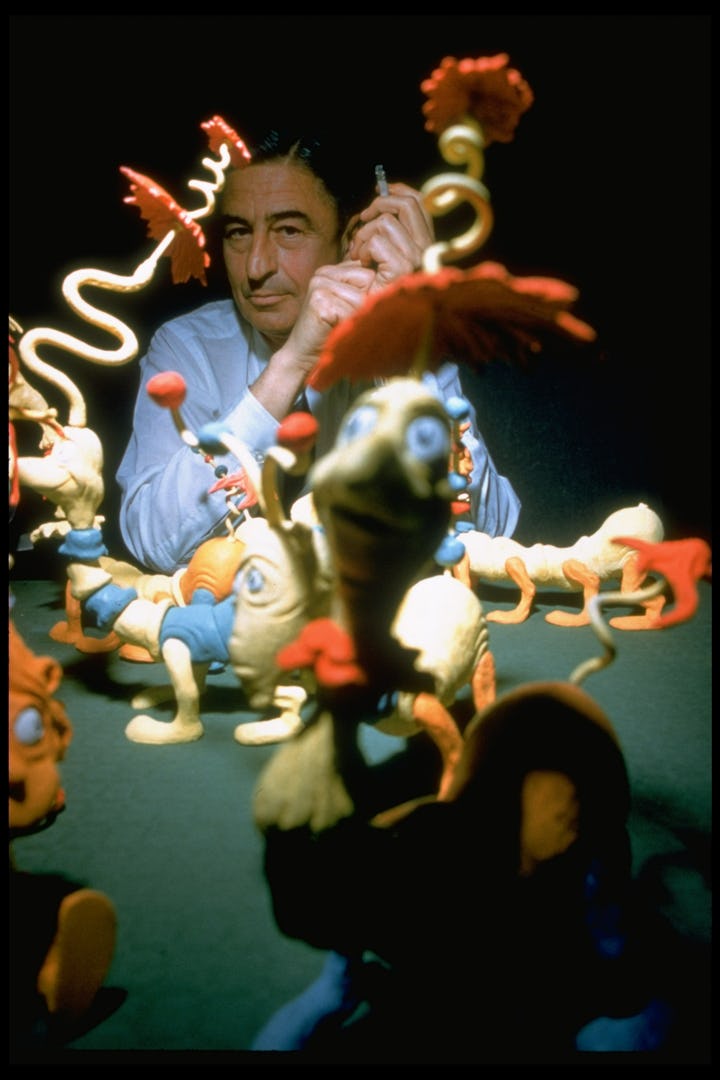60 Years Ago, One Simple Book Changed The Way Kids Read Forever
It’s all about three syllables.

Dr. Seuss was a master of doing a lot with a little. After all, this prolific author crafted Green Eggs and Ham with only forty-nine unique words! It was this minimalist approach that made him one of the most renowned children’s book creators of all time, but there’s one book that’s often left out of the conversation of Dr. Seuss’ finest works. Hop on Pop helped change how kids learn to read, remaining a classic today that’s just as effective now as it was when it was first published, six decades ago in 1963.
Theodor Geisel was a struggling cartoonist after he graduated from Dartmouth College in 1925. Using the Dr. Seuss pseudonym, Geisel had mild success through the ‘30s and '40s, but it wasn’t until The Cat in the Hat that he became a superpower in kids' literature. In the early '60s, he began working on educational “Beginner Books” for very young readers, including teaching them their ABCs, a barebones dictionary, and an introduction to reading from 1963 called Hop on Pop.
Pat defies gravity in this spread from Hop on Pop.
Marketed as “the simplest Seuss for youngest use,” these basal readers were a stark contrast to the competition of the time. The most comparable textbook would be the Dick and Jane series from the 1930s, which emphasized a “look and say” method of instruction. Hop on Pop focused on phonics, implementing “print to sound” techniques that offered a practical way of understanding how a word looked and sounded. Hop on Pop was specifically designed to go a level beyond The Cat in the Hat, a book that was already helping kids to read, now presented in an even more accessible format.
The book consists of short rhyming stanzas that can barely be called sentences. Its clever wordplay paired with amusing pictures engaged kids' imaginations to incentivize them to turn the page. Imagine seeing a tiny mouse standing atop a huge red house on one page, then witnessing that critter hoisting the same home on his back, walking off with it like it’s lighter than air!
That mouse never misses leg day.
Breaking down the poetry of Hop on Pop almost seems futile, simply because the art is in simplicity. It lacks the signature nonsense words seen in There’s a Wocket in My Pocket or wild tongue twisters like Fox in Sox, but it still has a Seussian rhythm, a cadence unique to itself. The repetition of sound is what’s most effective here, using a simplified version of the signature anapestic tetrameter that Dr. Seuss is best known for. For example, “Mr. Brown/ Mrs. Brown/ Mr. Brown upside down.” Seuss loved this type of rhythm because it evoked a humorous feeling with the words, almost like a limerick.
The writing of Dr. Seuss has come under fire many times, with some of his books being banned in some places. There’s certainly a case to be made for certain books with outdated racist stereotypes, like If I Ran the Zoo, and five others removed from publication last year due to this exact issue. However, it should be noted that these six books were voluntarily removed from publication by the estate of Theodor Geisel, making this a kind of self-cancelation.
Some have been more abstract, such as China’s ban on Green Eggs and Ham, removing it from circulation for over 30 years for its “portrayal of early Marxism.” Somehow, a book as deficient in words as Hop on Pop wasn’t free from potential banishment.
In 2014, Hop on Pop was challenged in Canada, when a Toronto library requested the book be banned due to the spurious claim that it could make children violent toward their fathers. The library rebutted, explaining the book in question urges children not to hop on pop, but to stop hopping on him. Dr. Seuss could be, in his own words, “subversive as hell” when it came to sneaking politics into his books, but the last thing he would ever promote is parental abuse. Not to mention, if a small child hops on pop in real life, it’s often delightful.
Oh, the words Dr. Seuss almost got away with if his publisher didn’t catch his sneaky prank!
However, there was one saucy line that didn’t make it into the final printing. The story goes that the good doctor was so meticulous at self-editing, that he believed the editors at Random House were shirking their responsibilities. One of the early drafts for Hop on Pop included the stanza, “When I read I am smart / I always cut whole words apart. / Con Stan Tin O Ple, Tim Buk Too / Con Tra Cep Tive, Kan Ga Roo.” Luckily, publisher Bennett Cerf caught this wordplay, correcting it before it saw the light of day.
Hop on Pop has been a critical part of many young children learning to read for one main reason. It’s not trying to teach, or be patronizing to its audience. Unlike Horton Hears A Who or The Sneetches, Hop on Pop is devoid of any moral lesson, other than cannonballing onto a parent isn’t such a great idea. It’s merely light fun that happens to be a gateway for kids to make the connection between sounds and words. Hop on Pop was a turning point that transformed the way reading is taught and is still a great read no matter how old you are.
Hop on Pop is available from Amazon and other retailers, or check it out at your local library.
This article was originally published on